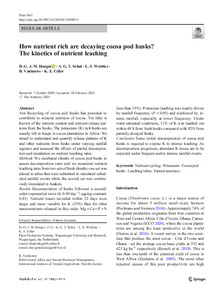| dc.contributor.author | Hougni, D.G. |
| dc.contributor.author | Schut, A.G.T. |
| dc.contributor.author | Woittiez, L.S. |
| dc.contributor.author | Vanlauwe, B. |
| dc.contributor.author | Giller, K.E. |
| dc.date.accessioned | 2022-09-16T09:39:07Z |
| dc.date.available | 2022-09-16T09:39:07Z |
| dc.date.issued | 2021 |
| dc.identifier.citation | Hougni, D.G., Schut, A.G.T., Woittiez, L.S., Vanlauwe, B. & Giller, K.E. (2021). How nutrient rich are decaying cocoa pod husks? The kinetics of nutrient leaching. Plant and Soil, 463, 155–170. |
| dc.identifier.issn | 0032-079X |
| dc.identifier.uri | https://hdl.handle.net/20.500.12478/7761 |
| dc.description.abstract | Aim Recycling of cocoa pod husks has potential to contribute to mineral nutrition of cocoa. Yet little is known of the nutrient content and nutrient release patterns from the husks. The potassium (K) rich husks are usually left in heaps in cocoa plantations in Africa. We aimed to understand and quantify release patterns of K and other nutrients from husks under varying rainfall regimes and assessed the effects of partial decomposition and inundation on nutrient leaching rates. Methods We incubated chunks of cocoa pod husks to assess decomposition rates and we measured nutrient leaching rates from two sets of husk chunks: one set was placed in tubes that were submitted to simulated scheduled rainfall events while the second set was continuously inundated in beakers. Results Decomposition of husks followed a second-order exponential curve (k: 0.09 day−1; ageing constant: 0.43). Nutrient losses recorded within 25 days were larger and more variable for K (33%) than for other macronutrients released in this order: Mg > Ca ≈ P > N (less than 15%). Potassium leaching was mainly driven by rainfall frequency (P < 0.05) and reinforced by intense rainfall, especially at lower frequency. Under water-saturated conditions, 11% of K was leached out within 48 h from fresh husks compared with 92% from partially decayed husks. Conclusion Some initial decomposition of cocoa pod husks is required to expose K to intense leaching. As decomposition progresses, abundant K losses are to be expected under frequent and/or intense rainfall events. |
| dc.description.sponsorship | NORAD |
| dc.format.extent | 155–170 |
| dc.language.iso | en |
| dc.subject | Nutrient Cycles |
| dc.subject | Potassium |
| dc.subject | Cocoa Pod |
| dc.subject | Leaching |
| dc.subject | Farmers |
| dc.subject | Agricultural Practices |
| dc.title | How nutrient rich are decaying cocoa pod husks? The kinetics of nutrient leaching |
| dc.type | Journal Article |
| cg.contributor.crp | Maize |
| cg.contributor.crp | Roots, Tubers and Bananas |
| cg.contributor.affiliation | Wageningen University and Research Centre |
| cg.contributor.affiliation | International Institute of Tropical Agriculture |
| cg.coverage.region | Africa |
| cg.coverage.region | West Africa |
| cg.coverage.country | Cote d’Ivoire (Ivory Coast) |
| cg.coverage.hub | Headquarters and Western Africa Hub |
| cg.researchtheme | Natural Resource Management |
| cg.identifier.bibtexciteid | HOUGNI:2021 |
| cg.isijournal | ISI Journal |
| cg.authorship.types | CGIAR and advanced research institute |
| cg.iitasubject | Agronomy |
| cg.iitasubject | Cocoa |
| cg.iitasubject | Natural Resource Management |
| cg.iitasubject | Plant Breeding |
| cg.iitasubject | Plant Production |
| cg.iitasubject | Smallholder Farmers |
| cg.iitasubject | Value Chains |
| cg.journal | Plant and Soil |
| cg.notes | Open Access Article; Published online: 11 Mar 2021 |
| cg.accessibilitystatus | Open Access |
| cg.reviewstatus | Peer Review |
| cg.usagerightslicense | Creative Commons Attribution 4.0 (CC BY 0.0) |
| cg.targetaudience | Scientists |
| cg.identifier.doi | https://dx.doi.org/10.1007/s11104-021-04885-1 |
| cg.iitaauthor.identifier | bernard vanlauwe: 0000-0001-6016-6027 |
| cg.futureupdate.required | No |
| cg.identifier.volume | 463 |

